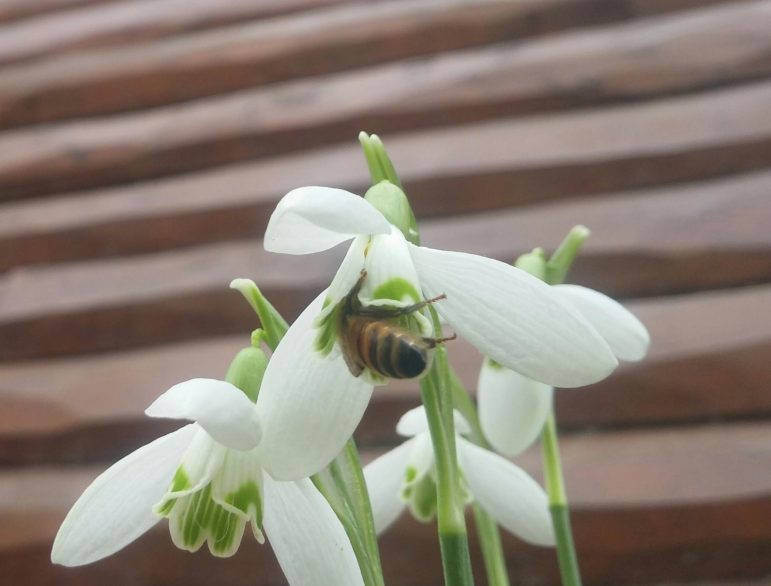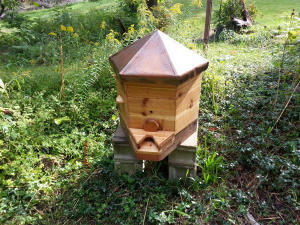
Image: Eric Lackie
By Max Johnston
Plenty of people have heard about the plight of the honeybee, as colonies have been disappearing for more than a decade. Across the country, people are getting into recreational beekeeping to do something about it.
Last spring, Eric Lackie went to check on the beehives in his backyard. He found what looked like a battlefield of bees. Overnight, a bear had gotten into Eric’s hives, entirely destroying one and nearly the other. The bees that survived were paralyzed by the freezing cold, so he rushed into action.
“I’m out there at like eight in the morning, picking up bees off the ground,” Eric says. “You just want to save as many as you can.”
Eric took the surviving bees inside, which he admits wasn’t ideal. He put the bees in his basement where it was dark, so they wouldn’t be too active. For the next few weeks Eric checked in on the hive regularly, and even fed them sugar water through a spray bottle.
In the meantime, he looked into getting revenge.

Eric Lackie removing, and adopting, a swarm of bees. Image: Eric Lackie
“I called up the DNR, and asked them ‘what are the limits on shooting a bear?’” Eric says.
After about two weeks the weather broke and he put the bees back outside. That colony survived.
Since the discovery of colony collapse disorder – the strange phenomenon of bees fleeing a seemingly healthy hive – people are joining Eric in this hobby. The number of beekeepers has nearly doubled in states like Maryland, Illinois and Florida.
While there’s no registry of beekeepers in Michigan, Terry Toland says the number has probably doubled. Toland is the president of the Michigan Beekeepers Association.
“We have a spring conference, and we’ve seen our numbers go from approximately 400 to 500 people to close to 1,000 people,” Toland says.
These people are hobbyists. They’re not in it for the “honey or money” so to speak.
Toland says many of these new beekeepers just want to help the bees. But rookie beekeepers may start out doing more harm than good, according to entomologist Meghan Millbrath.
“As a beginner, one of the greatest risks to bees is the beekeeper,” Millbrath says.
Millbrath has kept bees for over 20 years, and teaches classes to train new beekeepers. There’s a lot of demand for her classes these days.
“Because the increase came so quickly, a lot of the clubs and standard places for education weren’t able to handle that number of new beekeepers,” Millbrath says.
Millbrath says a big part of the problem is all the beekeeping ideas flying around the internet.

Steve Bentley’s Hexagon Hive. Image: Steve Bentley
“I have a three-hour class that’s basically just mythbusting about bees,” Millbrath says.
This can have consequences for the bees. Inexperienced beekeepers can mismanage a hive. Their bees can get sick and then spread diseases to other colonies.
Beekeeping wasn’t always this hard.
Steve Bentley has been beekeeping on and off for more than 30 years. Back when he started he didn’t have to worry about these problems; he just let his hives be.
“I didn’t even push it too much to learn anything. I knew there was a queen in there, and there was a bunch of bees,” Bentley says. “And I just let them go.”
Nowadays, a laissez-faire approach is a surefire way to lose bees. Bentley checks his hive regularly, buys the right equipment and jumps through all the hoops for his bees.
But it hasn’t helped much.
“The last two winters I’ve lost two hives each winter. Before December they’re gone,” Bentley says.
Bentley’s story is common among longtime beekeepers.
Honeybees are more vulnerable to pests and disease than ever before. Millbrath says that while beekeepers might lose some bees in the early stages, those bumps and bruises are a part of the process.
“One of the ways you learn about keeping bees, is from all those stupid mistakes you did, because those are the ones that stick in your head,” Millbrath says.
Even though Steve Bentley has lost his bees each of the past two years, that hasn’t stopped him. He says he thinks of the bees as pets.
Bentley has a chair right next to his colony. He says he loves to sit in the spring and watch the young bees leave the hive for the first time.
“They just fly all around the entrance for 15 minutes, they stretch their wings, and do their maiden flight, and they do orientations to see where the hive is,” Steve says.
Sometimes Steve lets a baby bee land on his hand, and watches it clean its wings.
This story was produced under a partnership of Michigan State University’s Knight Center for Environmental Journalism and Interlochen Public Radio.
I am a new Bee keeper, and yes I do think of them as my pets as well. I have planted flowers just for my bees, I have watered my flowers so that they do have enough pollen, I worry about bee beetles, wax worms, mites, and try to treat them with natural products, not drugs, I worry about the winter on how to keep them so that they survive, the problem is there is so many ideals that seem all good, but the survival rate is never mentions how is a New bee keeper to know which way or I should say the right way to maintain the hives so they will survive for years to come?